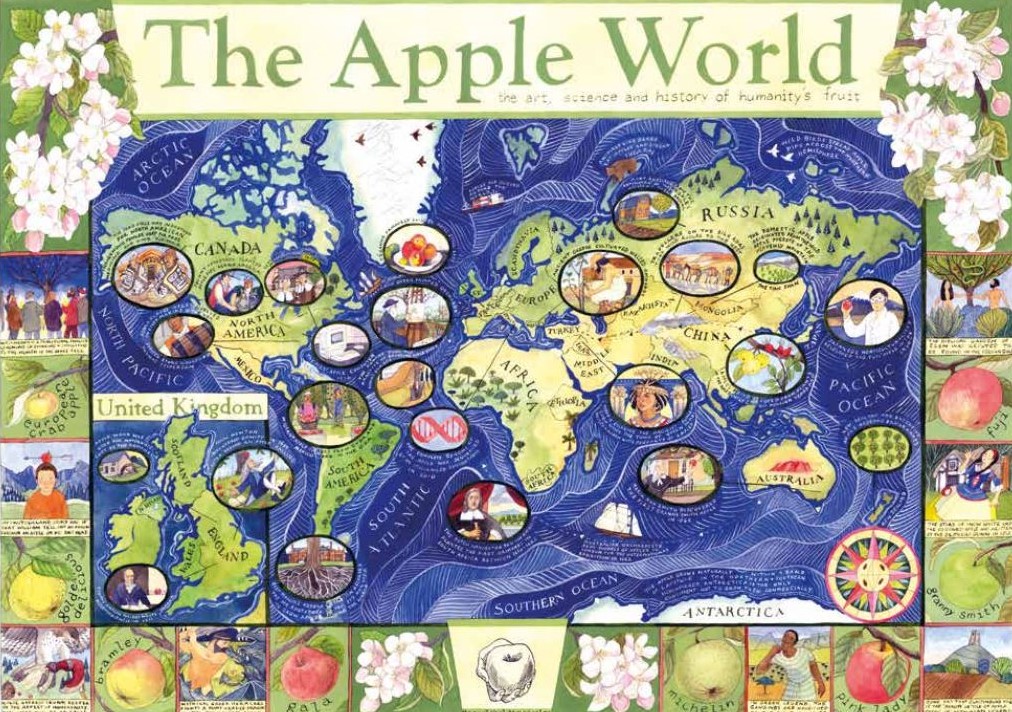29/02/2024

Apples, art and deep roots
Apples play an important supporting role in (art) history: from the one that once inspired Newton in terms of gravity, to the "Tell apple", to the one that Eve presented to Adam - although this is the first case of art forgery. That apple was probably not a Malus domestica but a Punica granatum, a pomegranate. From October 27, 2023 to January 28, 2024, artists at the Cider Museum in Hereford in the west of England have assigned the leading role to apples from the rose family. Illustrator Helen Cann was commissioned to draw a map depicting the apple's journey around the world, through time and different cultures. "The map is the basis for the stories of apples and people, which explore different aspects of humanity's close connection with apples and together provide the narrative for an amazing relationship."
The "centerpiece" of the exhibition are almost 150 lifelike apple models made in the 19th century that subtly connect the European continent with Australia: Apples, tart and bitter for making cider, sweet and crunchy served with cheese, or juicy and fresh for "apple pie" fascinated the British not only because of their visual variety: shiny green, ochre and warty, shimmering from rosé to red to purple. Russets, Ashmead's Kernel, Pippin, Pearmain, Brown Snout and Carlisle Codlin - around a third of all known apple varieties are said to have been developed in Great Britain. However, the production of the models was commissioned and financed by fruit growers in Australia. For a long time, people had to rely on botanical drawings for the description of varieties and classification, which at least showed the coloration of the fruit relatively accurately.
The models made of papier-mâché and wax, on the other hand, also show the size and surface structure of the apple, thus enabling a direct comparison. An important aid for the immigrants who voluntarily flocked from Great Britain to Australia in the 19th century, or who were shipped there by British courts in penal colonies. In order to survive, the new arrivals had to grow fruit and vegetables in a completely different climate and experiment with imported cultivars and native Australian varieties. Not only apples were produced as wax models, but also more than 50 other types of fruit, including apricots, avocados, hops, kumquats, tomatoes and sweet potatoes.
The collection in Melbourne comprises 1800 models and became not only an important source of information, but also a promotional tool for the promotion of business and agriculture in Victoria, the Melbourne region and for export. The latter was the reason for presenting a selection of apple models in 1862 at the "Great Exhibition" in London, the international fair for industry and art. The wax apples are now the centerpiece of the model collection at the Royal Botanic Gardens in Kew and can only be seen for the duration of the exhibition in Hereford. In the late 19th century, stylized apples found their way into English drawing rooms. William Morris, artist, textile designer and most important representative of the Arts and Crafts Movement, the British forerunner of Art Nouveau, transformed room walls into treetops with his apple wallpaper.
Not only in Switzerland and thanks to the legend of William Tell, the apple also plays a political role. In China, apples are presented on festive days as a sign of harmony, even when the circumstances are anything but harmonious. Hereford has a poster by Chinese artist Daxi Tang that was created towards the end of the Cultural Revolution: smiling people giving apples to soldiers of the People's Army. The Cultural Revolution was above all a time of denunciation and executions by the "Red Guards", to which millions of Chinese fell victim.
The withered skeleton of an apple tree dominates the back of one of the two exhibition rooms. The trunk and branches are completely covered in stickers that were often found on Golden Delicious apples, while the three apples on the floor are adorned with "Pink Lady" stickers. An installation by artist Anne Rook, who wants to draw attention to the lack of biodiversity and the standardization of apples - supermarkets only sell flawless fruit of identical size and color.
In contrast, a photo from around 1920 from the East Malling Agricultural Research Station. Scientists there prepared the root ball of an apple tree. The main roots can be seen extending broadly to the side with a dense network of fine and hair roots. This horizontal orientation is typical of weakly growing rootstocks. In strongly growing rootstocks such as meadow fruit trees, on the other hand, the roots extend vertically into deep layers of soil and provide the tree with a variety of additional minerals and nutrients. Photos from Jupiter Artland, a sculpture park near Edinburgh, are also on display. During his time as artist in residence in 2016, artist Alec Finlay created an art project there entitled "A Variety of Cultures". He installed 66 upright oak ladders and planted apple or plum tree seedlings of local varieties next to them. "The ladders serve to simultaneously anticipate and measure future growth; and ultimately they will be the means by which visitors can eventually climb into the crown of the trees to reach the fruit that thrives there," according to the Jupiter Artland website. (www.jupiterartland.org/art/alec-finlay-a-variety-ofcultures)
POEMS - FINLAY CALLS THEM "ECO-POETRY" - ARE ALSO PART OF THE ART PROJECT. AS WITH THE FRUIT TREE INSTALLATION, IT IS ALL ABOUT DIVERSITY AND TERROIR
THE FRUIT OFFERS A WELL-ROUNDED STORY. AN ORCHARD IS AN ARCHIVE OF THE PLACE. THEY ONLY THRIVE WHERE THEY BELONG. THE SAME APPLE - IN A DIFFERENT PLACE - IS A DIFFERENT APPLE. THE ONLY REAL SECURITY LIES IN DIVERSITY.
